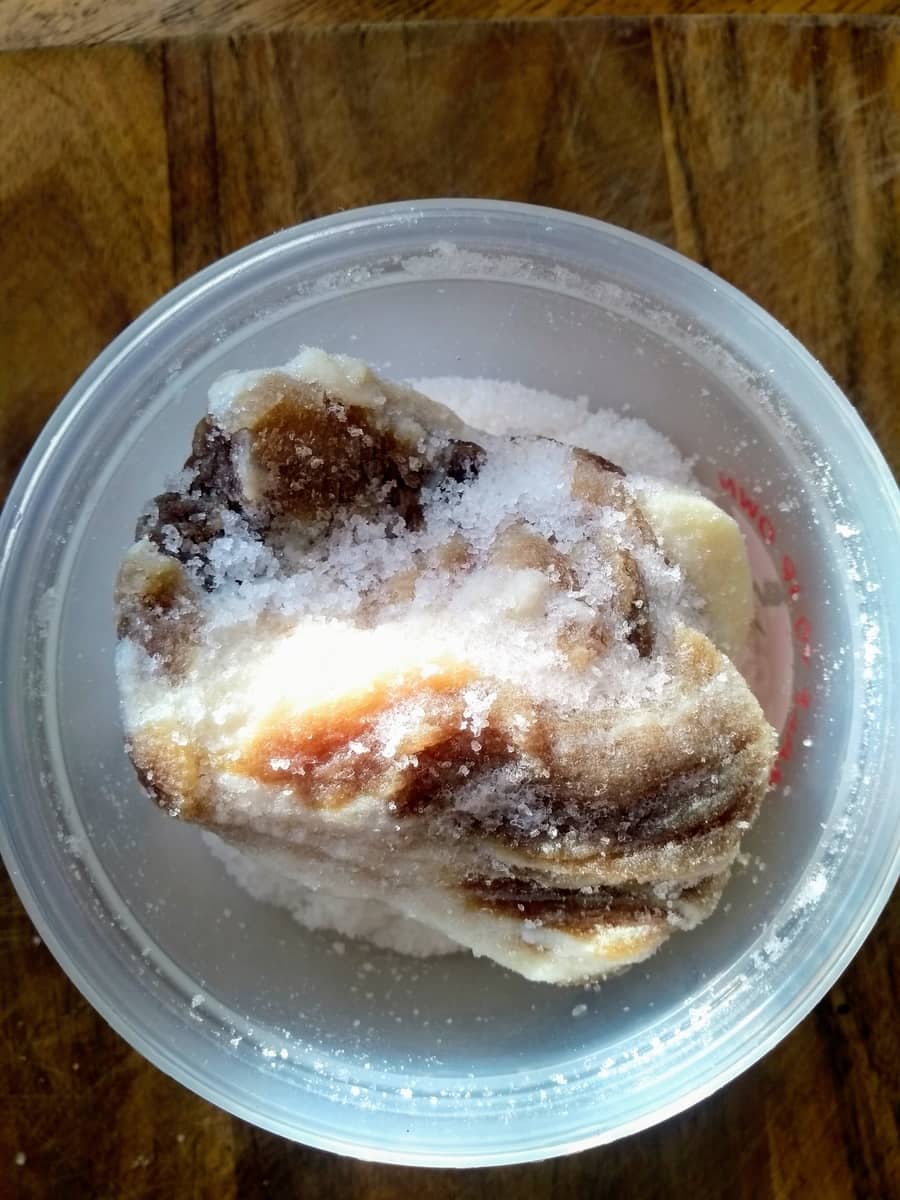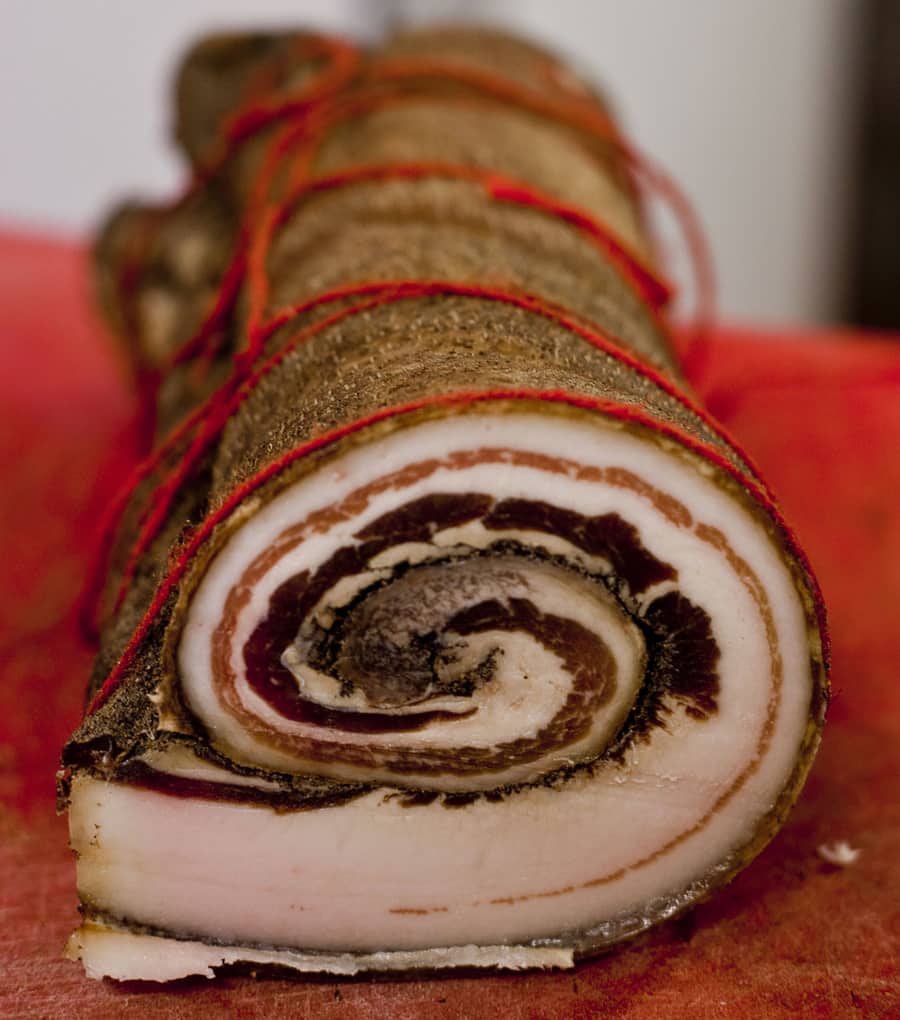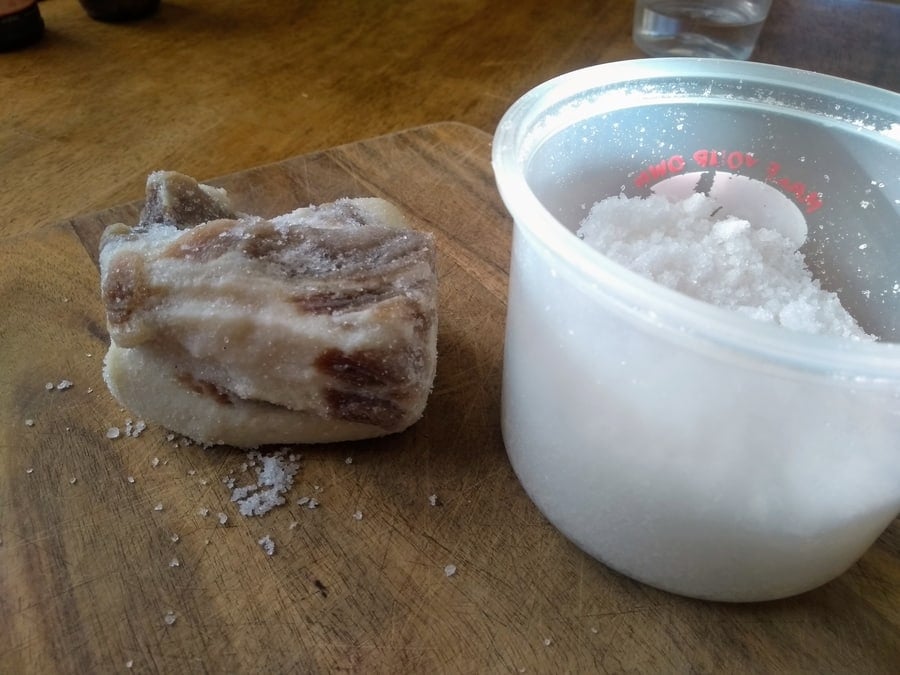Salt pork is a form of cured meat, initially used for long-term preservation before refrigeration.
It’s cost-effective since the pork is saturated with salt to preserve and often gives it a long shelf life; this was important in the pre-fridge/freezer era. In the modern era, it’s a form of extending the shelf life of a piece of fatty pork.
Salt pork does give a flavor, although it’s salt, pork, and saturated fat in the fatty meat.
I’ve been making salt pork at home for decades and purchasing it when needed.
The difference between salt pork and bacon is that bacon is smoked (hot or cold smoked). Bacon also has far less (80% or less) salt content than salt pork. However, the salt is removed somewhat before eating/cooking salt pork.
Key Points:
- Historically used for long-term preservation, salt pork is a simple cured meat made with sea salt and sometimes sugar.
- Its versatility makes it ideal for outdoor activities like fishing and hunting, adding intense flavor to various dishes.
- Salt pork is made by covering pork belly with sea salt (possibly sugar), leaving it in the fridge for 2-3 days, then rinsing and drying it. This will vary based on the size of pork meat used.
- The meat can last 6 to 12 months in the fridge or a cold area if cured longer.
- Salt pork enhances stews, casseroles, fried greens, baked beans, and seafood chowders.
- It’s a budget-friendly option with intense porky and salty flavors, perfect for slow cooking.
- Substitutes like pancetta, speck, and bacon offer more refined alternatives; more on this below.
Salt pork was very popular in the sailor and prairie days due to the preserving aspect.
I love to make and use it because it’s easy and tasty. It’s a simple recipe. It’s one of the many salt-cured meats I’ve discovered over the decades of making craft meats.
Homemade salt pork is back-to-basics in the form of cured meats. It is great for outdoor adventures, fishing, and hunting and can be used for that meaty, intense flavor in meals.
Most importantly you don’t have to carry the water in the meat, in raw meat it’s often 70%!
Defining Salt Pork
Essentially, it is a fatty piece of pork with a high concentration of salt saturating it – it’s done by dry salt curing or wet salt curing. Sometimes, both methods are applied.
Commercially made salt pork is often in a saltwater brine and vacuum packed. Traditional or homemade salt pork is often heavily salt-saturated and then dried for weight loss and preservation.
Fat is vital for dried salt pork since it contains less water than muscle meat. Therefore, it doesn’t lose as much weight.
Commercially made pork is often injected with salt brine to ‘weigh’ more, if you look at the packaging you’ll often find this solid looking piece of meat – has a large portion of water and less meat.
Once you take enough moisture from the meat, it is preserved through salt (& sugar if you want). It can’t spoil very quickly, and that’s why it has historically been used in long ship voyages of discovery.
It was used on boats sailing worldwide hundreds of years ago. I have also read that it was common in many military campaigns because of its long shelf life.

Classic Recipes and Popular Uses:
Here’s the updated list with quick explanations for your additions and no full stops:
- Stews – Adds rich, salty flavor to hearty stews
- Casseroles – Enhances casseroles with smoky depth
- Fried with Greens – A classic pairing, especially with bitter greens
- Baked Beans with Salt Pork – Adds savory, smoky richness to baked beans
- Seafood Chowder with Salt Pork – Elevates the chowder with a salty, umami boost
- Clam Chowder with Salt Pork – A traditional ingredient for authentic flavor
- Cornbread Stuffing with Salt Pork – Rendered salt pork adds a savory depth
- Potato Soup with Salt Pork – A creamy soup enhanced by the richness of salt pork
- Salt Pork Hash – Diced potatoes and salt pork fried together
- Homemade Baked Navy Beans – A traditional slow-cooked classic
- Collard Greens with Salt Pork – A Southern favorite
- Flavored Gravy Base – Rendered salt pork drippings add flavor
- Fried Cabbage with Salt Pork – Crispy, smoky, and satisfying
- Boston Brown Bread with Baked Beans and Salt Pork – A classic pairing
- Salt Pork and White Bean Cassoulet – French-inspired comfort food
- Salt Pork Dumplings – A twist on dumplings by adding rendered fat
- Fried Rice with Salt Pork – A smoky addition to stir-fried rice
- Corn Chowder with Salt Pork – Enhances this creamy dish
- Salt Pork Cracklings – Crispy, rendered salt pork as a snack or topping
- Pork and Vegetable Stir-Fry – Salt pork cubes stir-fried with seasonal veggies
- Split Pea Soup with Salt Pork – Adds depth to this hearty soup
- Salt Pork and Spinach Frittata – A savory breakfast or dinner option
- Salt Pork Pasta Carbonara – A richer alternative to pancetta
- Salt Pork-Crusted Fish – Wrap fish in slices of salt pork for cooking
- Salt Pork and Cornbread Skillet – Render salt pork in a skillet, then bake cornbread over it
- Lentil Soup with Salt Pork – Adds flavor to earthy lentils
A Base Flavor for Many Dishes
As I mentioned, I love to use this when I’m camping because it can be kept in a cool environment for a few weeks quickly, potentially months. Adding it to wild game stews for an extra porky flavor or using it for an oil frying replacement.
Of course, remember that you don’t need to add salt to the recipe if you use salt pork. You can always add the salt at the end to finish it off if it needs more.
Salt pork is also a great ingredient to have. If you cook a bit slow/using a crockpot style, it can boost the flavors of the dish, and again, you only need to use a small amount.
Classic Examples
Boston Baked Beans
This is a Boston classic that can be made in the slow cooker. The salt bacon gives it that angle, combined with all the other spices.
This awesome recipe from Pioneer Woman doesn’t soak the salt pork; it depends on how salty it is to start with, though.
New England Fish Chowder
I don’t know what it is about pork flavor with chowder, but it just goes together incredibly well. Clams, scallops, mussels, or other seafood can produce unique flavors.
Slow Cooking & Cheap
Whether you buy or make it, the best thing about salt pork is that it is relatively inexpensive. Although commercial industrialization of the cured meats industry has created many products with poor quality types of meat, it’s about the speed of production rather than any concerns about animal welfare, quality, or nutrition).
Soaking Salt Pork Before Use
Often, this is done before you even begin to cook the dish. As its name will tell you, salt pork is soaked in loads of salt to help preserve it.
To prepare salt pork for consumption, you must soak it to draw the salt out (osmosis). Depending on the packaging and amount of salt used, you may need to wash the meat for at least 2-3 hours. Exchange the water you are soaking your salt pork in every hour to expedite the amount of salt withdrawn from the pork.
Tip – You can test fry some pork after an hour of soaking to gauge how much salt concentration is inside.
The longer you soak your salt pork, the more salt will be withdrawn. Considering that your salt pork will have been sitting in a vat or container of salt, you can recognize how this process will affect the safety and flavor of the meat.
The salt content in meat will try to equalize its concentration in the freshwater used (known as the osmosis process).
Salt pork, salt fish, salt beef – all made similarly so they didn’t go rancid or off quickly, historically to preserve without refrigeration – since the domestic fridges have not been invented.
Some recipes may skip the soaking and use the salt in the pork as part of the seasoning for a stew, for instance.
Substitutes & Alternatives for Salt Pork
These are similar but different; bacon and speck are often some form of smoked meat. Pancetta is a traditional dry-cured Italian salumi that can be used for cooking – by frying or slicing thinly for a tasting platter.
Salt pork is a more rudimentary style of cured meat – it will be saturated in salt versus other substitutes below (to illustrate – I use 2% salt to the weight of meat for pancetta, speck, and bacon. For salt pork, it’s 10%. This is for one method of meat curing I use)
Similar but different being more refined, fancy substitutes for basic salt pork:
- Pancetta
- Speck
- Bacon

How Long Does Salt Pork Last in Fridge

If you cook with salt pork, you might only use a portion of the meat. Perhaps you would like to save a bite for a meal later in the week. Or, you hope to bring some additional (uncooked) salt pork with you on a camping trip.
You should always refrigerate commercial salt pork when it is not in use, and you can refrigerate it. While it can last up to two weeks unrefrigerated, salt pork can last for 4-5 months and even longer frozen.
Reading the instructions should give you an idea.
To refrigerate salt pork, it is best to wrap it and seal it as well as possible. The more tightly sealed your meat is, the longer it can be expected to last.
When your salt pork is repeatedly exposed to higher temperatures, this creates the opportunity for the development of bacteria that can make meat unsafe to eat, but since it’s immersed in salt harmful bacteria struggle to get into the meat, it’s also because of the lack of water activity.
Fortunately, as salt pork is prepared through a curing process pre-packaging (whether commercially made or homemade), it can last longer out of the refrigerator compared to standard meats.
Why Salt Pork Goes Bad and Spoils
It depends since there are several ways it can spoil.
Some commercial industrialized products are not thoroughly salt-cured/saturated and fall into this category. They are not shelf-stable; they should be kept in packaging. Also in the fridge.
As mentioned, some of these are the water-injected types that are designed to be consumed once the packaging has been removed.
Temperature: As per above, salt pork, in particular, needs to be kept in refrigeration.
Sun exposure can make salt-cured pork fat yellow and cause it to become rancid with a particular smell.
I’ve had first-hand experience with this when making homemade salt-cured pork.
Read the packaging and also trust your nose in all situations. If in doubt, dispose of the salt pork.
Lengthy off-the-shelf life due to its curation process. Homemade salt pork soaked in salt brine or dry-cured can last 18 months. Particular commercial salt pork go bad after 1.5-2 weeks unrefrigerated, 2-3 months refrigerated, or 6 months frozen.
It depends on the bacterial inhibition level and how long it has been cured in salt (for homemade types).
Air will quicken the deterioration of salt pork, as with any meat, whether cured or not (oxidizing).
The type or style of salt pork will also depend on how quickly it spoils.
Commercial Vs. Homemade Salt Pork
If you are new to working with salt pork, you might not be familiar with using this type of meat in your diet. However, those in New England (USA) will tell you this is a treat you will not want to miss.
The flavor that salt pork can add to baked beans or clam chowder, for example, is enough to elevate your recipe (in some recipes, you don’t soak the salt pork before cooking; the amount used in the recipe is key, though).
Commercial Industralized Salt Pork
The difference between commercial and homemade salt pork. Commercial salt pork is generally from a pig’s underbelly. It’s usually cured and packaged for months in a refrigerator, inside its salt brine.
Commercial salt pork will look similar to bacon, as it is often sealed in thick plastic. You can also tell the difference in its lean proportions, as the coloration and fat are visible in the package. However, many commercial salt pork products are sold worldwide.
Of course, when cooking with salt pork, you might not be trying to get the leanest cut as you would with other pieces of meat. After all, the point of using salt pork in many dishes is to render the fat and add flavor in this manner.
Homemade Salt Pork
Homemade or Traditional Salt Pork is dried.
This is much more shelf stable and can last in a moderate climate without refrigeration since it has generally lost 50% or more moisture, which makes it harder for unwanted bacteria to spoil the salt pork.
During the Age of Sail, salt pork was commonly preserved and stored in barrels filled with strong brine to prevent spoilage on long sea voyages.
Commercial vacuum-packed, quickly wet-cured/brined salt pork does not last long once removed from its plastic packaging.
Can Salt Pork Be Eaten Raw
The salt is embedded and saturated into the salt pork during curing. You must cook the salt pork before consumption or soak it in fresh water to draw out the salt. While the meat is dry-cured, this does not mean that it is safe to eat raw.
Does Salt Pork Need to be Refrigerated?
The safest bet you can have for whether or not you should keep it in the fridge, of course, is to look at the expiry or best-before date.
Ideally, it should be kept in the fridge. It can be hung in a cool, moderate temperature for months. Depending on how saturated it is with salt, this will greatly affect how long it lasts. Some commercial salt porks aren’t designed to be hung.
Is Salt Pork Belly Easy to Cook?
Salt pork belly can be quickly cooked in three main ways. Rendering the fat for its flavor, adding cubes directly into a dish, and frying small crispy bits as an exterior garnish. You can use it in various dishes, including New England Clam Chowder, Boston Baked Beans, or your favorite vegetable.
If you haven’t tried it, here is a guide on how to make salt pork.

Tom Mueller
For decades, immersed in studying, working, learning, and teaching the craft of meat curing, sharing the passion and showcasing the world of charcuterie and smoked meat. Read More
